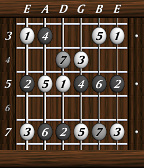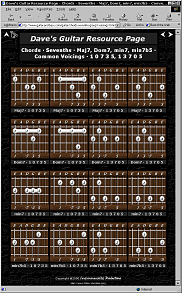|
Press Release:
October 22, 2000
Dave's Guitar and Bass Resource Pages
http://www.davegrossman.net/guitar-and-bass/
Introduction:
Dave's Guitar and Bass Resource Pages is actually multiple independent sites that all share the same structure and material. The content of each site is customized for each instrument. Currently, only the six-string guitar and six-string bass versions are posted. I plan on having four and five-string bass versions up soon and then later in the year, seven-string guitar and seven-string bass versions.
These sites are the result of over a decade of research and experience in applying music theory to stringed instruments using computers. The goal of these sites is to provide a complete reference for music theory and its application to the guitar and bass. This is a monumental task that will be an ongoing project for me for many years to come.
Content:

These sites feature high-quality fretboard charts illustrating scales, chords, arpeggios, and other musical concepts. The charts were generated by custom software that I developed called DynaChart which is an unreleased Windows version of InterChart, a Java applet I wrote and posted over 4 years ago. DynaChart was designed to allow the efficient generation of nearly any conceivable guitar chart with high-quality graphics. It is my belief that visualization can make the learning of complex musical concepts easier and more enjoyable.
The guitar section currently over 250 pages of content with over 1000 charts available online for free. I am also offering a CD-ROM version for $15 that includes additional material and higher quality images. Left-handed charts will also be available on the CD-ROM version. Since these pages will be evolving and growing for many years to come, I will be allowing CD-ROM owners to upgrade their purchase to new version for $5. For a limited time, those who purchase the CD-ROM version will get one free upgrade.

The major sections in each site include Basics, Scales, Chords, Arpeggios, and Harmonics. The Basics section includes information about intervals and note letter names. The Scale section has definitions and patterns for dozens of scales including all modes of the Major and Melodic Minor scales. The Chords section has charts for triads, sixth, seventh, ninth, eleventh, and thirteen chords. Two approaches are taken with chord voicings. There are some voicings that can be applied to multiple chord types such as triads, sixth, and seventh chords. These are called 'common' voicings and chords with common voicings are presented together to demonstrate the relasionships between them and how one chord can be changed to another simply by changing a single note. There are also 'special' voicings which are voicings that, for various reasons, cannot physically be played for most chord types. These are presented separately. There is also an Arpeggios section that takes the scale patterns and illustrates how arpeggios fit within the scales. Simple arpeggios that span a single octave on the intervals 1, 3, 5, and optionally 7 are presented along with extended arpeggios that span two octaves on the intervals 1, 3, 5, 7, 9, 11, and 13. A Harmonics section which is still under development will include scale and chord charts that include natural harmonic notes.
Philosophy:
The philosophy behind the use of the charts at this site is based on the fact that there is a link between music theory, mathematics, and the physical positions of notes on a fretboard. When learning music theory and applying it to an instrument such as the guitar or bass, the application of that theory manifests itself in note positions on a fretboard. It is my belief that using visual representations of this theory can aid in learning and allow a musician to more thoroughly exploit scales, chords, and arpeggios that may be too complex to easily visualize in the mind.
The goal is not to rely on these patterns but to learn them so well that they become second-nature. Instead of thinking about what scale, chord, arpeggio, or combination thereof to play at a particular point, the musician already knows the sound of what they want to play, their sub-conscious knows how to implement it end their fingers have the facility to play it.
Future Development:
I have plans to add much more material and additional sections. Chord Progressions, Technique, Lessons, and other material will be added over time. I would also like to add MP3 audio clips, staff and tablature notation, photographs, and possibly MPEG video clips.
Status:
These sites are still in their initial phase of construction. There is enough material there to keep a guitarist or bassist busy for months but I have plans for adding a lot more material. The amount and frequency of updates will be affected by the success of the CD-ROM sales. The income from the CD-ROM sales will pay for the hosting, software, and hardware needed to help me realize the full potential of the site.
Support:
Please help support this site by giving a link to:
Dave's Guitar and Bass Resource Pages
http://www.davegrossman.net/guitar-and-bass/
scales, chords, arpeggios, and more presented with
theoretical definitions and related resources
Or use the following banner ( only 21kb ):
or the non-animated version ( only 9kb ):
|